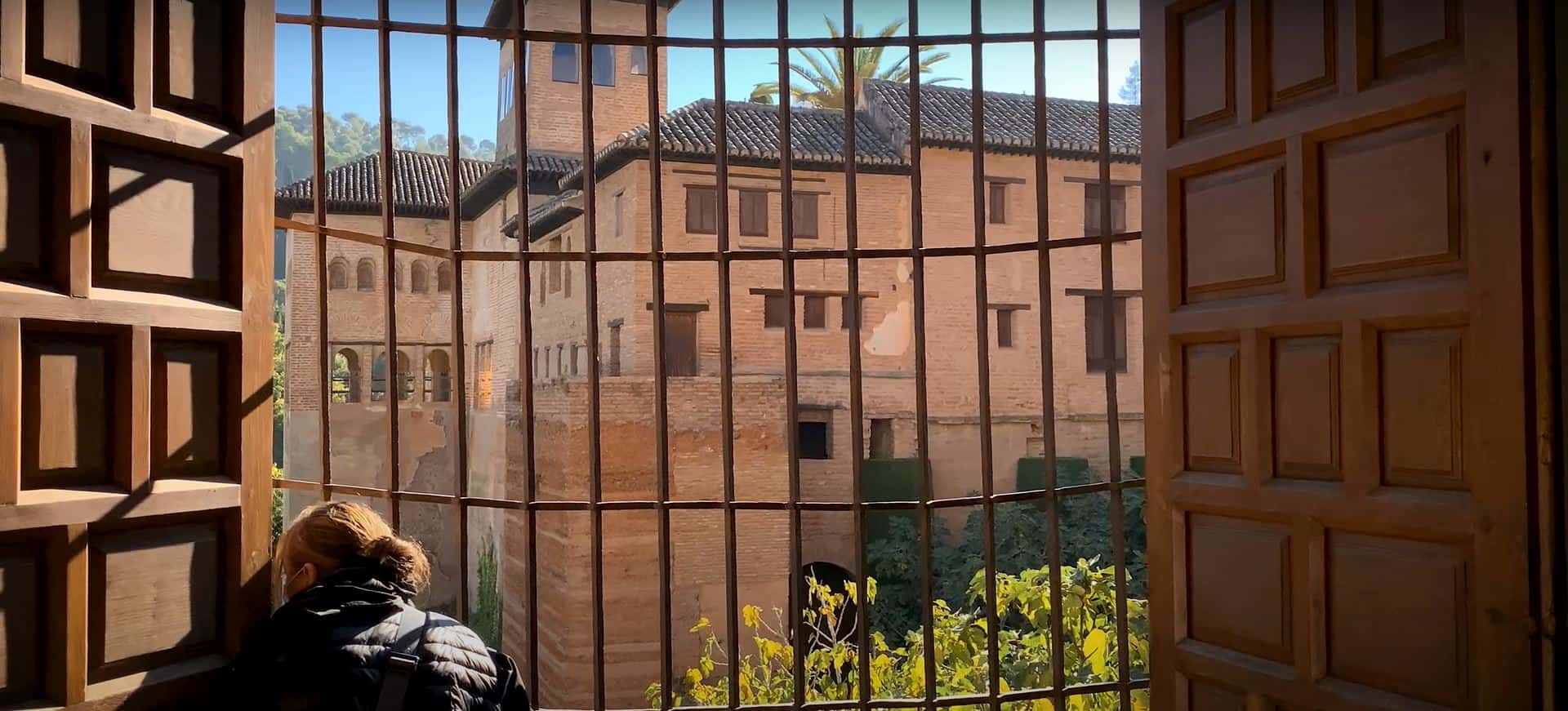Nasrid Palaces | Alhambra | Andalusia | Granada, Spain

Updated On: April 16, 2024 by Maha Yassin
In the heart of the sun-kissed Andalusian landscape, where history whispers through the ancient stones, the Nasrid Palaces at Alhambra are a breathtaking embodiment of a bygone era. Enveloped in the rich tapestry of Islamic heritage and Moorish craftsmanship, these palaces evoke a sense of wonder and reverence that transcends centuries. As we journey through these hallowed halls and manicured gardens, we’ll delve into the captivating story of the Nasrid Palaces, discovering the echoes of their legacy in the enchanting city of Granada, Spain.
Unveiling the Nasrid Dynasty: Guardians of Alhambra’s Legacy
The Nasrid Palaces, also known as the Palacios Nazaríes in Spanish, were constructed during the Nasrid dynasty’s reign in the 13th to 15th centuries. This dynasty ruled the Emirate of Granada, the last Islamic stronghold in the Iberian Peninsula before the Christian Reconquista, a period during which Christian kingdoms sought to recapture the lands under Muslim rule for centuries.
The Nasrid Palaces Dynasty
The Nasrid dynasty, founded by Muhammad I in 1238, marked the peak of Islamic culture and art in the Iberian Peninsula. Despite the political instability of the era, the Nasrid rulers managed to establish a flourishing kingdom centred around Granada. During this period, they witnessed the construction of the Alhambra, including the Nasrid Palaces, which would later become an enduring symbol of Islamic Spain’s rich heritage.
The Alhambra’s Significance
The Nasrid Palaces stand as a testament to the resilience of Islamic culture and architecture in the face of political and religious turmoil. During the Reconquista, the Alhambra was a political stronghold and a cultural haven for the Nasrid rulers. The palaces, with their intricate design and opulent decorations, reflect the dynasty’s commitment to preserving and celebrating their Islamic heritage.
Architectural Splendor
The Nasrid Palaces are renowned for their exquisite architectural features that blend Islamic, Moorish, and Andalusian influences. These palaces are prime examples of the Mudejar architectural style, characterized by its decorative plasterwork, intricate tile mosaics, horseshoe arches, and geometric patterns. Here are some key elements that make the Nasrid Palaces a marvel of Islamic architecture:
Court of the Myrtles (Patio de los Arrayanes)
Upon entering the Nasrid Palaces, visitors are greeted by the stunning Court of the Myrtles. This rectangular courtyard features a long reflecting pool surrounded by beautifully landscaped gardens. The name “Myrtles” is derived from the myrtle bushes that line the pool’s edges. The pool’s reflective surface creates a mesmerizing visual effect and serves as a central focal point.
Comares Palace (Palacio de Comares)
The Comares Palace, also known as the Palacio de Comares, is one of the most iconic structures within the Nasrid Palaces. Its main highlight is the Hall of the Ambassadors (Sala de los Embajadores), which features an intricately designed wooden ceiling adorned with star-shaped patterns. This hall was where the Nasrid rulers held important diplomatic meetings and receptions.
The Hall of the Abencerrajes (Sala de los Abencerrajes)
The Hall of the Abencerrajes is another architectural gem within the Nasrid Palaces. Its name is derived from the Abencerrajes, a noble family whose members were tragically executed within this hall. The star-shaped dome ceiling, adorned with ornate stucco work and tile mosaics, is a prime example of the Islamic influence on Mudejar architecture.
The Palace of the Lions (Palacio de los Leones)
Perhaps the most famous of the Nasrid Palaces, the Palace of the Lions, or Palacio de los Leones, is an exquisite example of Islamic art and design. At its centre stands the Court of the Lions (Patio de los Leones), featuring a central fountain with twelve marble lion statues, symbolizing strength and power. The courtyard is surrounded by elaborately decorated rooms, including the Hall of the Two Sisters (Sala de Dos Hermanas) and the Hall of the Mocárabes (Sala de los Mocárabes), both of which showcase stunning stucco work and tile mosaics.
Generalife
Although not part of the Nasrid Palaces themselves, the Generalife, located adjacent to the palaces, is an integral part of the Alhambra complex. This area consists of beautiful gardens, orchards, and a summer palace. The Generalife gardens are a tranquil retreat where visitors can appreciate the art of Islamic horticulture.
Cultural Significance
The Nasrid Palaces offer invaluable insights into the culture, art, and lifestyle of Islamic Spain during the Nasrid dynasty’s rule. Here are some of the cultural aspects associated with the Nasrid Palaces:
Islamic Art and Architecture
The Nasrid Palaces are prime examples of the magnificence of Islamic art and architecture, showcasing the intricate geometric patterns, calligraphy, and use of light and water characteristic of Islamic design. These architectural features testify to the Nasrid rulers’ appreciation for aesthetics and dedication to preserving their Islamic heritage.
Courtly Life
The Nasrid Palaces provide a glimpse into the opulent courtly life of the Nasrid dynasty. The various halls and chambers within the palaces served as venues for ceremonies, receptions, and meetings with foreign dignitaries. Elaborate decorative elements, such as stucco work and tile mosaics, adorned these spaces, creating an atmosphere of grandeur and refinement.
Water as a Symbol
Water plays a significant role in the design of the Nasrid Palaces. The use of fountains, reflecting pools, and intricate irrigation systems not only adds to the aesthetic appeal but also symbolizes the importance of water in Islamic culture. Water is seen as a symbol of life, purity, and spiritual cleansing, and its presence throughout the palaces reflects these cultural beliefs.
Historical Significance
The Nasrid Palaces are a testament to Islamic art and culture and a reminder of the complex history of the Iberian Peninsula. As the region’s last stronghold of Islamic rule, the Alhambra and its palaces symbolize the enduring legacy of Islamic Spain and its eventual integration into Christian Spain after the Reconquista.
Preservation and Restoration
Over the centuries, the Nasrid Palaces have undergone various phases of restoration and conservation efforts to ensure their continued survival. These efforts have included repairing structural damage, conserving decorative elements, and implementing measures to protect the palaces from the effects of tourism and environmental factors.
The detailed work of preservation and restoration has allowed modern visitors to experience the Nasrid Palaces as they appeared during the height of the Nasrid dynasty’s power. The attention to detail and commitment to preserving these palaces’ historical and architectural integrity have garnered international acclaim.
Visiting the Nasrid Palaces
Visiting the Nasrid Palaces is a journey back to Spain’s bygone era of Islamic splendour. Here are some practical tips for those planning a visit:
- Tickets and Timings: Due to its immense popularity, booking tickets well in advance is advisable, especially during peak tourist seasons. The Nasrid Palaces have specific entry times; arriving on time for your designated slot is essential.
- Dress Code: Visitors are required to dress modestly when entering the Nasrid Palaces. This includes covering shoulders and knees as a mark of respect for the cultural and religious significance of the site.
- Guided Tours: Guided tours are available and highly recommended to gain a deeper understanding of the history, architecture, and cultural significance of the Nasrid Palaces.
- Photography: Photography is allowed within the palaces, but the use of flash is prohibited to protect the delicate decorations and artworks.
- Allow Sufficient Time: Plan to spend several hours exploring the Nasrid Palaces, as this architectural wonder has much to see and appreciate.
Beyond the Nasrid Palaces: Exploring Granada’s Cultural Tapestry
The Nasrid Palaces of Alhambra are undoubtedly a focal point of cultural and historical significance in Granada, Spain. However, the surrounding area offers a wealth of attractions and experiences that complement your visit to this iconic site. Here are some noteworthy attractions near the Nasrid Palaces:
- Generalife Gardens: Adjacent to the Nasrid Palaces, the Generalife Gardens are a tranquil oasis of lush greenery and beautifully landscaped terraces. Stroll through these gardens to appreciate the serene beauty and intricate Islamic horticulture.
- Alhambra Fortress (Alcazaba): Within the Alhambra complex itself, the Alcazaba is a medieval fortress that offers panoramic views of Granada and the surrounding countryside. Explore its towers and walls for a glimpse into the military history of the Nasrid dynasty.
- Carlos V Palace (Palacio de Carlos V): This Renaissance palace contrasts the Nasrid Palaces’ Moorish architecture. It houses the Alhambra Museum, which showcases artefacts and exhibits related to the site’s history.
- Albayzín District: A short walk from Alhambra, the Albayzín district is a labyrinthine neighbourhood of narrow winding streets, white-washed houses, and Moorish architecture. It’s a UNESCO World Heritage site in its own right and offers a unique glimpse into the city’s medieval past.
- Sacromonte Caves: Known for its distinctive cave houses, Sacromonte is a vibrant neighbourhood where you can experience traditional flamenco performances and learn about the region’s Romani culture.
- Royal Chapel of Granada (Capilla Real): Located in the city centre, the Royal Chapel houses the tombs of Catholic Monarchs Ferdinand and Isabella, whose reign marked the end of Muslim rule in Spain.
- Granada Cathedral (Catedral de Granada): Adjacent to the Royal Chapel, this magnificent Gothic cathedral is a testament to the city’s transition from Islamic to Christian rule.
- Mirador de San Nicolás: For the quintessential Alhambra viewpoint, head to the Mirador de San Nicolás in the Albayzín district. From here, you can capture postcard-perfect views of the Nasrid Palaces against the backdrop of the Sierra Nevada mountains.
- Science Park (Parque de las Ciencias): If you’re interested in science and technology, the Parque de las Ciencias is a modern museum with interactive exhibits, a planetarium, and a butterfly house.
- Tapas Bars and Restaurants: Granada is famous for its tradition of offering free tapas with drinks at many bars. Exploring the local culinary scene and savouring the flavours of Andalusian cuisine is a delightful experience.
These attractions and experiences near the Nasrid Palaces of Alhambra provide a well-rounded exploration of Granada’s rich history, culture, and natural beauty, making your visit to this enchanting city all the more memorable.
Conclusion
The Nasrid Palaces of Alhambra stand as a testament to the rich history and cultural heritage of Andalusia, Spain. These exquisite palaces, with their intricate architecture and lush gardens, provide a glimpse into the opulent lifestyle of the Nasrid rulers and the enduring legacy of Islamic Spain. Visiting the Nasrid Palaces is a journey through time, where visitors can immerse themselves in this remarkable period’s art, history, and culture. As a symbol of Spain’s multicultural past, the Nasrid Palaces continue to captivate and inspire all who have the privilege of experiencing their beauty and historical significance.






